|
FAQs on Flasher Wrasses, Genus Paracheilinus
Disease/Health
Related Articles: Flasher Wrasses,
Related FAQs: Flasher Wrasses, & FAQs on:
Flasher Wrasse Identification,
Flasher Wrasse Behavior, Flasher Wrasse Compatibility, Flasher Wrasse Selection, Flasher Wrasse Systems, Flasher Wrasse Feeding, Flasher Wrasse Reproduction, &
Wrasses, Wrasse Selection, Wrasse Behavior, Wrasse Compatibility, Wrasse Feeding, Wrasse Diseases,
|
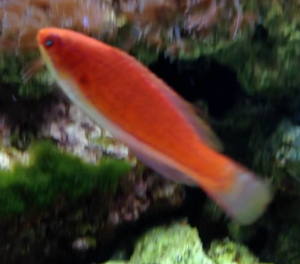
|
exquisite wrasse ailment/behavior 2/22/17
Dear WWM crew,
<Cindy>
I am a very inexperienced aquarist, having just begun a tank this past
September. Wrasses are the most delicate fish I've attempted and the first
didn't live through quarantine (flukes, I think).
<May be>
I have a had a juvenile female (I think) exquisite wrasse in quarantine
for 10 days. I was told by the owner of my LFS (an awesome guy) that she had
been treated with copper, PraziPro and Chloroquinine phosphate while in the
store. Days 1-10 she seemed very healthy. She is in a 10 gal
tank aerated with 2 airstones and going through TTM, so the tank is uncycled.
She has tolerated the moves very nicely, hiding for maybe 20 minutes
after each move with some color change but recovering quickly. I treat the water
with Seachem Prime in addition to monitoring ammonia and scrupulously removing
waste.
<Mmm; expect me to state something/s regarding the trade off of
preventative steps versus induced stress/disease>
Yesterday her fins seemed clamped, breathing a little fast and swimming a little
listless. Her tail also seems ragged. All of these changes were very subtle but
after losing the first wrasse I have been on high alert for trouble. I added 1/2
dose PraziPro to the tank, watched a bit. She seemed ok and I had to go out for
a short time. When I returned she'd been in
PraziPro bath roughly 2 hours and was clearly struggling to swim. I was
concerned she wasn't tolerating PraziPro (I have read anecdotal reports that
some wrasses don't) so I did a 50% water change (salinity 1.022, matched the
tank but the temp of the added water was a couple degrees warmer than the tank
I'm afraid) and added a hang - on filter with
carbon. During the water change she exhibited drastic color change, laid on the
floor a couple minutes, then hid behind a PVC and has been there since breathing
fast. She hasn't eaten.
<I'd NOT treat further, and would expedite the moving of this fish to the main
display. Any further delay will NOT add to the likelihood of disease avoidance
and WILL add to the potential loss of this specimen>
Hindsight being what it is, I think now that I over-reacted by adding the
PraziPro. When laying down her fins are clearly NOT clamped. I can't see her
tail to tell if it is actually ragged. My instinct is that she's stressed and to
leave her be, maybe she'll come out later. Do you suggest I do
differently?
<Yes; move this fish as stated>
I don't want to stress her to death, I know she is delicate. I just want to get
her into my display tank, I feel she is
safest there.
<Agreed>
Thank you so much,
Cindy
<Thank you for sharing. Bob Fenner>
|
Sick flasher
2/21/15
I obtained a small flasher wrasse (not sure if this is a carpenter or a
yellow fin, maybe you can help identify)
<The more distinct markings on the caudal; though I can't see much
darkening on the posterior proximal dorsal, I make this out to be a
Carpenter's>
on Feb 13. I housed this in an isolation box with a
lineopunctatus flasher (with dividers) beside it.
<Mmm; these fishes REALLY don't like being penned in...>
In the system also have 4 flavo anthiases which (the male is pictured) I
think has been slowly losing weight (all 4 Anthias.)
<Common AND REAL trouble... Need to bolster nutrition, AND lace the
foods with anti-protozoal AND anthelminthic med.s: Metronidazole and
Prazi are my choices>
The anthiases have been eating Reef nutrition ArctiPods and Cyclopeeze
2x a day but I have noticed that they have large bellies and getting
really thin.
<As stated; okay, hinted above; likely internal issues>
They sometimes swim slanted like "/" but sometimes normally, Im not sure
if it is my high flow.
<Mmm; could be damage in collection... being brought up too quickly>
The system is around 40Galons total with sump/skimmer/chiller and some
corals (it is actually a QT system)
<I'd rapid transit these fishes into a larger setting>
Anyway, just today, I noticed this lesion on my small flasher
wrasse. Any chance you can help identify it?
<Appears to be physical damage to me... VERY common (am getting to not
like these capitalizations) with these genera... JUMPING!>
Should I remove this wrasse to another tank so the sickness does not
spread?
<Again... am NOT a fan of much/any isolation of these fishes in small
volumes... Would rather dip/bath and put straight away into their
main/display system>
I have read about myobacterium marinum, if this is the case, how do I
rid my QT tank of it?
<Let's not go there this eve; too involved and not necessary>
Thank you.
<Welcome Michael. Bob Fenner> |
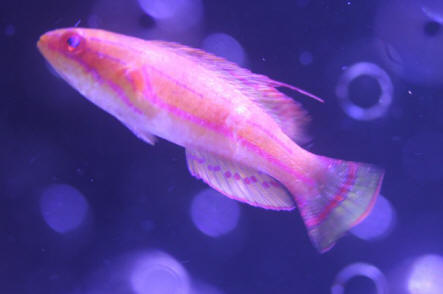
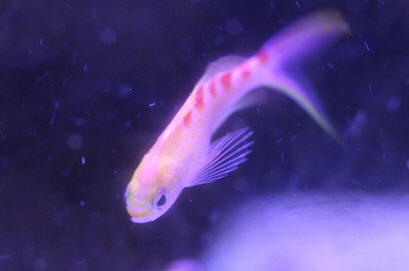 |
|
Re: re: Sick flasher
2/22/15
Thank you for the fast response! This is another picture of another flasher
that I bought. carpenteri or flavianisis?
<The latter... though you've misspelled flavianalis. B> |
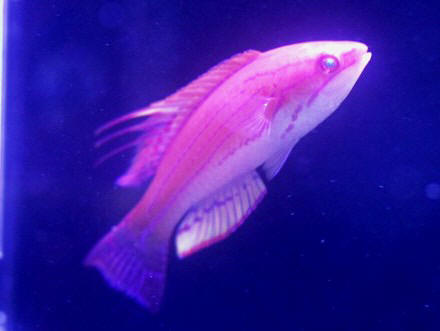 |
|
Big bulge on one side of new McCosker's
1/18/15
Hello,
Two weeks ago I purchased a McCosker's, Blue Flasher and two Line Spot
wrasse from a large online retailer. They are being housed in a 29 cube
QT.
<I'd be moving these fishes ASAPractical... will damage themselves in
such a size, shape system>
I soaked their food in Met on day two and on day 5 treated the tank with
PraziPro. I lost a Line Spot on day 6, it had a lesion (sore) on one
side of it's bladder area. I'm feeding Larry's Reef Frenzy 3 times a day
allowing them to eat all they can for 2 to 3 minutes. No uneaten food is
left in the tank. Water Prams are all in range, salinity is 1.025 and
temp 79.
Tonight during feeding I noticed the McCosker's belly had a huge bulge
on the left side only.
<I see this in your next email's following pix>
It had already ate several mouths full of food when I spotted it. It's
swimming fine and has no marks or sores visible. The other fish are all
eating, swimming and look normal.
I treated the QT with a second application of PraziPro tonight. Is there
anything else I should or can do if this bulge is still present
tomorrow.
Please see attached photos. Thank you in advance for any advise.
Sincerely,
Debbie Hollifield
<Looks to be some "shipping damage"; perhaps from needling post-capture
(not uncommon, and being discussed by some on Facebook currently)... Not
anything I would "do" other than provide good care, expedite the
quarantine... As the animal is feeding, behaving normally otherwise,
this will likely self-heal. Bob Fenner> |
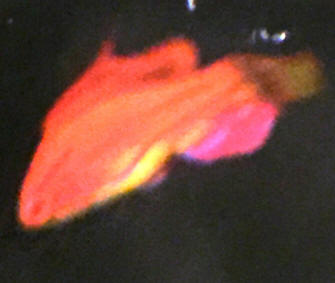
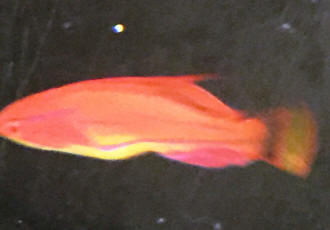 |
Lineatus fairy wrasse swimming problems; hlth., stkg./sel.
3/11/13
Hello wwm crew,
<Joe>
This is my first time sending an email but I am on the website just
about every day for info, very informative!
Keep up the great work
Anyway on with my problem, I purchased a 5" " super male"
lineatus fairy wrasse 10 days ago.
<Mmm, better to start with smaller specimens... adapt better to captive
conditions>
I bought if from a lfs that I have had good success buying fish from in
the past. I received the fish in the bag from my lfs supplier and I
placed it into my 56G quarantine tank which has been running since last
October. I set up a drip for about an hour then moved him in. The tank
has an Eheim 350 canister filter, aqua c remora pro skimmer with 60lbs
live rock.
Ammonia-0, nitrite-0, ph-8.1, nitrate-10ppm, temp78 deg, solidity 1.025.
The lighting is a small led set from marineland.
He was eating right away and was looking good the entire time he was in
quarantine so I decided to move him into the main tank after a week, I
know it was not a good idea
<I would have done the same>
as I like to quarantine at least two weeks and I have no excuse but
impatience, so back to the topic, I moved him with no net as he swam
into a container and I poured him into the DT as the perimeters are the
same as my quarantine tank( 180g tank, 30g sump with refugium, 3 EcoTech
Radion led lights, aqua c ev-240 skimmer, HC gfo and carbon reactor, 230
lbs live rock and assorted lps and soft corals, red bubble anemone, 4
cleaner shrimp, male-female flame wrasse, pair of percula clowns, sail
fin and chevron tangs and a female lineatus wrasse. Ammonia, nitrite-0,
nitrate-1, phosphate-.03, ph-8.1, temp-77.5, solidity 1.025.)
At first he was in hiding and wouldn't come out for the first day,
except to eat. I realized it was the lighting being to intense so I set
a new program with an acclimation periods for him to adjust and he was
out in no time swimming around all day which explains why he was doing
good in the dim lighting of the quarantine tank. The second day went by
with no issues and he looked great.
I noticed at night on the second day in the DT he was having a problem
releasing his bowels and when he finally did it was large and solid and
mostly white so I removed it from the tank to inspect for possible
parasites but I couldn't see anything.
On the third day he started off good, but I noticed a bulge in his
stomach, on his right side towards the bottom, and he was swimming a
little crooked, leaning to the opposite side of the bulge. After feeding
the tank around 11am spectrum pellets and some Mysis shrimp he was
swimming erratically, unbalanced and he seemed lost. Later on around 6pm
I fed Mysis again and he ate a lot and about a half our later he was
completely out of control, swimming upside down and in circles so I
quickly netted him and held him upright with my hands so he could regain
his composure which he did in about 5 minutes then I let him go and he
went to sleep for the night.
He woke up the next morning swimming good again, not perfect but good,
so I added SeaChem Metronidazole with focus to some Mysis and fed the
tank sparingly which he ate. After feeding there were no real bad
balance issues but I did notice two white things attached to his gill
area which he was rubbing on the rocks so I attempted to help remove
them and they fell of in the tank as I grabbed him, I don't know what
they were. As the day progressed I noticed the bulge getting larger and
after the evening feeding the erratic swimming came back, but not as bad
as the day before.
So with my long story being told(sorry) I want to know what you think
might be wrong here?
<Perhaps a "worm" (or more than one) problem here>
Do you think I'm heading in the right direction with the Metronidazole?
<I'd add an anthelminthic.. see WWM re.>
Or is it a issue of constipation?
Should I move him back to the quarantine tank and treat/observe him in
there?
D you think my other fish are in danger of getting sick?
<Not likely. Such issues tend to be more species, genus specific; and
often the parasites have complex life cycles; w/ intermediates missing
in captive systems>
Please let me know what you think and what I should do going forward.
<Add the vermifuge to the foods>
Thank you very much,
Joe Marino
<Welcome. Bob Fenner>
Re: Lineatus fairy wrasse swimming problems
3/11/13
Hello Bob
<Greetings Joe>
Thank you for the quick response, much appreciated.
This morning when I left things were ok, he was a little tipsy but not
much but when I got home it was not good. He is swimming in circles and
just looks lost. I moved him back into the quarantine tank and held him
in my hand to help him gain control of himself. I turned the lights off
and put him in a hiding spot in the quarantine tank in hopes he will
regain some composure.
It really saddens me to hold this beautiful fish in my hand in this
condition.
Anyhow, can you advise me on how or where I can get some of the medicine
you suggested I try?
<Yes; please just use the search tool (on every page on WWM) for
Praziquantel... available most everywhere. BobF>
Thank you
Joe Marino
|
Hurt Carpenter's Flasher Wrasse 12/24/12
Hello,
<Hey Brent>
It's Christmas Eve, but I thought I would send this out because I woke up
this morning and noticed that my Carpenter's Flasher Wrasse appears to have
a chip of his head gone. It is a pretty big spot. It doesn't look like an
ulcer spot, but rather it appears to be a possible bite.
<Mmm, appears to me to be an all-too common injury from these fish's
jumping...>
This is the same Carpenter's Flasher Wrasse that was flashing the Lime
Green Wrasse (Halichoeres chloropterus), which was looking much more
like a mating flash than just an aggressive flash. What is odd is the
Carpenter's Flasher Wrasse has the apparent bite on its head and the Green
Wrasse is acting unusually aggressive. This normally shy, coy, and sweet
fish was seeming to be very aggressive. Normally, when I would come up and
look in the tank she would hide and peak around the rocks and then come out
and visit, before she would dart away. Only to do the same thing again.
However, today she was almost standing me down. She would approach the tank
with her mouth open and would then quickly flip stirring up the sand and
hitting the side of the tank. It was almost like she was protecting
something. I don't know if the two fishes situations are connected but I
almost wondered if she aggressively took a bite out of the Flasher Wrasse?
<Doubtful>
Any ideas? Any insight into the change in the Green Wrasse's behavior? As
for the wound of the flasher, should I just let it heal itself and wait
watchfully, or should I take another action?
<Just leave all as is... Do check to make sure there are no openings in the
top/cover that the Wrasses can launch themselves out of your system. Folks
w/ lots invested in Paracheilinus, Cirrhilabrus... often have soft screen
covers twixt their tank and lighting>
I have attached some photos of what looks like what I would think was a
bite. I'm going to upload the video of the aggressive behavior on my site.
When I do, I will send a link.
Thanks so much. Have a wonderful Holiday!
Brent Wells
<And you as well. Not to worry; such injuries almost always heal in a few
weeks time. Bob Fenner>
|
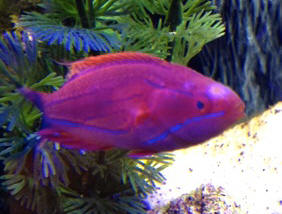
|
Re: Follow up- Carpenter's Flasher Wrasse 12/29/12
Hello Bob,
<Hi Brent>
Just a follow up on the Carpenter's Flasher Wrasse with the marks on it. If
you remember, on Christmas Eve I noticed he has a big mark on his head that
appeared to me to look like a bite. Now the little guy looks worse. He not
only has the mark on his head which really doesn't look any better, but he
also has a few more marks on his head and body.
<I see this/these in your pix>
One of them is on his head and the other a little further down on his
side. He looks rough.
<Actually; this fish looks "good" to me... is healing, has a good index of
fitness (is "full", not hollow bellied... bodied)>
You had mentioned making sure he couldn't jump out. We are good on that end.
It is a bow front with a lid. The one area he could jump out of we have a
mess screen covering it, so they are all secure.
<Good>
I'm obviously concerned he looks worse, rather than looking better.
Could a small hermit crab cause such a mark?
<Highly unlikely; no... perhaps if the fish were dead, on the bottom>
I know the wrasse likes to hide down in the sand/rocks to sleep. Could a
small zebra hermit crab cause something like this? Or, do you feel this
could still be from the fish jumping.?
<Most likely by far jumping>
I've never seen him even act like he wanted to jump, although i know he
could. I'm sending a few more pics. He is so quick it is tough to capture a
clear pic. Just want to make sure I'm watching for the right things.
Thanks,
Brent
<I urge patience here, only. Bob Fenner>
|
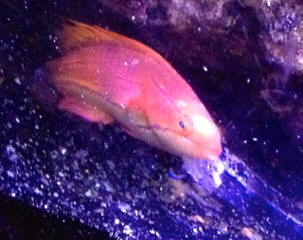 |
Re: Follow up- Carpenter's Flasher Wrasse
1/1/13
Happy New Year, Bob!
<And you Brent>
Well, my year is not off to a good start. Really sad morning. I had both
the Lime Green Wrasse (Green Wrasse (Halichoeres chloropterus) and
the Carpenter's Flasher Wrasse die. I watched the Lime Green
Wrasse burrow last night but this morning she was laying on the bottom
of the tank lifeless. She has been fine except for the more aggressive
flashing I mentioned a few days ago. The Carpenter's Flasher Wrasse was
really odd. As we were taking the green wrasse out of the tank, we saw
the Flasher Wrasse come rolling out from the rocks where it was
sleeping. It looked stiff and curved. It's fins were all spread out, but
it was on the bottom lifeless.
All of a sudden it would dart around the tank. Then, it would stiffen up
and fall to the bottom of the tank again. It did this for a while. I've
never encountered this before. It finally died. I Immediately checked
the water conditions. Everything was looking good: Amm: 0, Nitrite: 0
Nitrate: 0 pH 8.1, Salinity: 1.023, Temp 78.9, Phosphates 1.0.
<Mmm; well the spg is a bit low, the HPO4 high>
They had both been eating: Mysis shrimp with Selcon, Spectrum pellets,
some MegaMix at times. The Flasher Wrasse was always eating, while the
Lime Green Wrasse would disappear and sleep a long time, then she would
appear all shy. They both were such fun, beautiful fish. I don't
understand them both dying so close together. Water conditions are
great.
<Ahh, for what we can measure>
It is such a peaceful tank. The Flame Angel fish would on occasion chase
the Flasher Wrasse away, but besides that, they all seemed to get along.
The chasing only happened on occasion. The Flasher Wrasse's death was
odd.
It was like it was paralyzed and then it would try to swim but it's fins
wouldn't work. I have attached a link to my quick I phone movie in my
DropBox Folder. I thought it may help if you see what it was doing. The
only odd things have been that we have had two Turbo Snails die and two
small dwarf hermit crabs die. We can't explain it, since we did an
almost 5 hour acclimation to the DT. I wouldn't know if they could be
connected?
<Perhaps... the two biggest categories of guesses as to root cause are
"something" in the system... a worm? Eaten, touched? Or consequent
collection, handling, shipping damage...>
Besides the bump on his head that two were healthy great fish. Any ideas?
Would love to know what you think of the short iPhone clip? Thanks
as always. Today is a sad start to the year, since they were two of my
favorite fish. Here's the Link:
https://www.dropbox.com/s/lapbmu5wjblhrkc/wrasse.MOV
<Mmm, can't get this to come up>
Thanks- Brent
<Welcome. Bob Fenner>
Brent Wells shared wrasse.MOV with you; Re Paracheilinus death
1/1/13
Brent's message:
"Bob, I got your message that the link didn't bring the video up. Not
sure why it wouldn't, but here is different link. It is so odd, I am
curious at what you think? You mentioned, "<Perhaps... the two biggest
categories of guesses as to root cause are "something" in the system...
a worm? Eaten, touched? Or consequent collection, handling, shipping
damage...> These have been in the main display for awhile, so would that
rule out the last part?
So when you say, "worm", I'm not sure what that would mean?
<<Having seen your video now... w/ the nice Chlorodesmis, the
Paracheilinus spazzing about, am more convinced that it ate "something"
(a Polychaete worm of some sort?), got punched by an Alpheid, or badly
stung... again, there are quite a few possibilities. Perhaps a read
here:
http://www.wetwebmedia.com/toxicvenpoisf.htm
Any recommended action, or something I should concentrate my search on? A
killer worm in my tank that could take out two of the fish, what should
my stance be with concerning the other fish? Thanks - Brent Wells"
Click here to view the video:
https://www.dropbox.com/el/?r=/s/lapbmu5wjblhrkc/wrasse.MOV&b=clk:None:37215
17480925352149:1310:647&z=AACFCgkDZkI9cCBYnp7dXeXd-FDxsyQ4NpifPYLiKwYxlw
(Brent shared this file using DropBox. Enjoy!)
<I saw it; but not enjoyably. Cheers, B>
Re: Brent Wells wrasse 1/1/13
Bob,
First, sorry about the "enjoy" attached to the video. That was an
automated add on by DropBox.
<Oh; understood>
The movie definitely wasn't enjoyable to watch. So if we go with the
worm premise, it is difficult to choose course of action. Some started
from scratch, while other did significant water changes. I'm still
reading but I'm not making a connection as to potential next steps.
<Well... some folks might over-react and use a Vermifuge to kill the
worms in a given system (I would not)>
I meant to ask but do the turbo snails release a toxin when dead?
<Not really; no... their decomposition can detract from water quality...
but all would be mal-affected>
One of the turbo snails was not found for a few days and wondered if they
would eat that and cause something like this? It is possible that these
would be very difficult for me to ever spot in the tank, correct?
Brent
<Not so hard to detect at times... Errantiates and other worms can be
baited, lured out... trapped, mainly at/by night.
Do read here re:
http://www.wetwebmedia.com/wormcompf.htm
and the worm compatibility FAQs links above.
Bob Fenner>
|
|
Question: Carpenter's Flasher Wrasse, damaged mouth
12/10/12
Hello WetWebMedia Crew:
<Hi Brent>
I have a question concerning my Carpenter's Flasher Wrasse. I noticed
today that its mouth appears different. The upper lip is white. I can't
tell if it has damaged its lip by burrowing deep in the sand and rubble
or if I should be concerned with some mouth fungus?
<Likely a "scrape" from burrowing/contact with a rock.>
He darts around the tank at times, so my first thought was he just
scraped it, but then I started getting concerned it may be something
more. Either way, at what point should I be getting concerned about it?
<This will likely be a somewhat common occurrence. I would not be
concerned unless it quits eating.>
If it has just damaged it mouth, should I just let it heal itself, or is
this something I should treat?
<Offer a well balanced diet and it will heal naturally; no medications
necessary.>
If it is some fungus, what is my best option with the wrasse since it is
my understanding they are sensitive to many treatments? I have attached
a couple of pictures in hopes it may help in the diagnosis. Thanks so
much.
<Quite welcome.>
Brent
<Jordan>
|
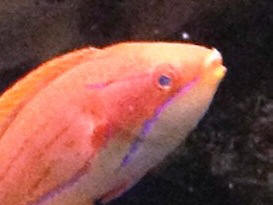
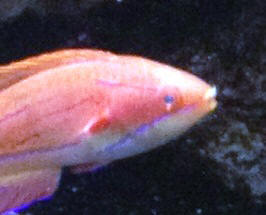 |
|
Carpenter Wrasse White Streak/Spot on Eye
6/3/12
Hello All!
<Jonathan>
Let me start by saying, I love your site, and all the good work you do!
That being said, I was hoping you could help me out with a Wrasse
problem.
When looking at my Carpenter Wrasse yesterday, I noticed it has a white
somewhat raised looking streak/spot on it's left eye.
<I see this in your photos>
I have had him (could be her, but I stick with him for grammar's sake)
for about 6-7 weeks now. The first 4 of which were in quarantine.
My main tank was fallow for about 7 weeks before I put him (and a
Percula Clownfish that I got at the same time) in it, and he looked very
healthy in quarantine, with no signs of disease or stress. His
behavior hasn't changed one bit and he is swimming happily all over the
tank and seems to be eating just fine. I don't think he has
PopEye, as his eye is not bulging at all, however, I worry that it could
be some sort of fungus, parasite or bacterial infection. In
reading your site, I am hopeful that its a simple injury and that it
will heal on its own,
<Yes; and this is almost assuredly all this is... t'were there another
cause, both eyes would be affected>
but I would like to get your opinion. I have attached two photos
(taken from my phone so there not the best) that show his eye.
Currently, my tanks specs are:
29g Biocube w/ about 30lbs. LR
Ammonia, Nitrite, Phosphate are all 0
Nitrate ~ 5ppm
pH is ~ 8.1 - 8.2
Temp 78
Salinity 1.026
Running standard Biocube lights and pumps with an added powerhead,
UV-sterilizer, and homemade protein skimmer
Live stock includes:
1 Percula Clownfish
1 Carpenter Wrasse
1 Skunk Cleaner shrimp
1 Rose Bulb anemone (any advice on getting my CF to host in him would be
greatly appreciated)
1 Electric Blue hermit crab
6 dwarf hermits
12 Astrea snails
4 Nassarius snails
And a few corals
Any help you can give me figuring out what is going on and how to treat
it would be great.
<I would do nothing here. Simple good maintenance will see this fish
improve>
Thanks for all your help!
Jonathan
<Welcome. Bob Fenner>
|

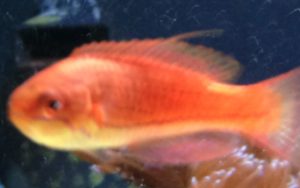
|
Re: Carpenter Wrasse White Streak/Spot on Eye & New Sickness
6/10/12
Hi Bob,
<Jon>
Thanks for the quick reply for the email below. I wanted to give
you an update on my Wrasse and see if I could get your take on him.
<Ok>
As a reminder, my Wrasse had a white streak on his eye. I believed
it was an injury because he was not acting any differently. In
your reply you agreed and said I just keep up with my normal routine.
<Yes>
A couple of days later, my Wrasse became a bit lethargic. He would
sit in his cave for a portion of the day (which he never did in the
past), acting more like he was resting than becoming skittish.
Since he has been more stationary I have been able to get a better look
at him. His eye problem is still there, no better or worse, but
now it looks like he has a white scale on him. The best way to
describe it is to say it looks patches of dry salt (no individual dots
as you expect with Ich). As I haven't noticed this before, I am
worried that he has some sort of disease. I have attached two
pictures of him. The first is a picture of the white scale, and
the second is a better picture of his eye (now that he is stationary).
<I see this>
Any help you could give in diagnosing him, and a possible treatment plan
would be great. Please note that tank parameters are the same as
in the email below except for the addition of a Lettuce Sea Slug or
Nudibranch today.
<My position is the same... a physical injury. I would not treat this
system for it; will resolve on its own w/ time>
I look forward to hearing from you. Thank you for your help!
Jonathan
<Welcome. BobF>
|
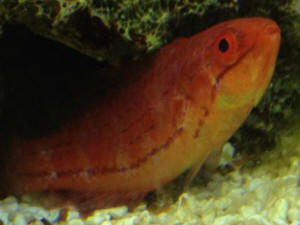
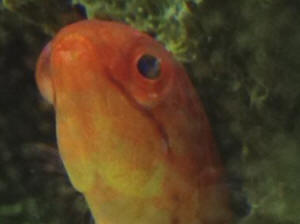 |
|
Sudden death of red-tailed flasher
wrasse! 7/8/11
Dear WWM Crew,
<David>
It is with great sadness that I recount today's events leading up
to the fairly sudden death of our beloved red-tailed flasher wrasse.
I'm wondering if you can speculate a cause of death, as I can't
think of any satisfying hypotheses.
<Let's see>
The system: 225-gallon mixed reef tank, reasonably heavily stocked with
both corals and fish-- but all carefully chosen for compatibility.
Tunze 9410 skimmer, ozonizer set at 370 mV ORP, lots of carbon and GFO
filtration,
<... do you have "real" troubles w/ HPO4? Am not a fan of
continuous use of this product>
changed every 2 weeks for carbon and every 4 weeks for GFO, wet dry
sump with all bioballs removed and replaced with Seachem Denitrate
crushed "rock", automated home-made continuous water changer
that changes 3% of the water every day (broken into small amounts 150
times a day) with aged Reef Crystals + RODI water at 1.0255 sg,
automatic top off with RODI water, 10 micron mechanical filtration (a
pool filter, changed every two weeks), flow provided by mechanical
filter return (1500 gal/hr), sump return (500 gal/hr), and four Vortech
MP40s (total of 5,000 gal/hr at current settings), 1 L of NPX
biopellets in a TLF 550 reactor, illuminated by six Aquaillumination
Sol Blue LED units.
The water chemistry: 0 ammonia, 0 NO2-, 3 to 5 ppm NO3-, 0.00
phosphates
<... need some. Cut back on the GFO>
(by Hanna photometer; I have actually been trying to increase phosphate
levels slightly to facilitate nitrate export by NPX-fed bacteria, which
seem to be phosphate-starved currently), 460 ppm Ca++, 450 ppm K+, 0.06
ppm iodide, 4-8 ppm Sr++, 7-8 ppm dissolved O2, 1500 ppm Mg++ (normally
1350 ppm but recently added 150 ppm Kent Tech M over 5 days to inhibit
Bryopsis growth), sg = 1.0255, temp = 79-81 deg F.
The situation: this morning I noticed that the large, beautiful,
normally-in-perfect-apparent-health red-tailed flasher wrasse (male,
purchased in March from Live Aquaria Diver's Den, grown rapidly to
4", perfect physical condition, no tattered fins or swollen
places, no sign of Ick or velvet disease, eating very well, fat, very
active and flashing daily with two smaller female red-tailed flasher
wrasses in the same tank) was behaving oddly. Instead of his usual
swimming and flashing while waiting for food, he was swimming slowly,
closer to the bottom than usual, and "gasping" as if having
difficulty getting oxygen. Coincidently, I just measured oxygen levels
at 8 ppm last night, so I don't think the water quality was an
issue.
<Me neither>
He did not eat this morning, which is very unusual for him. Also, his
coloration was partially in "stressed mode", and he was not
chasing or flashing his harem.
(In retrospect, the previous night he also behaved a bit oddly-- he
came out after his bedtime (around 10 pm daily), with his night
time/stressed coloration, and settled under a different rock compared
with his usual sleeping hole. This observation may or may not be
relevant).
After breakfast (which he did not eat), he settled under the new rock
for several hours, before moving yet again to a hole in a different
rock. By noon he had his full night time/stressed coloration showing,
but otherwise relatively asymptomatic. One odd observation-- at this
point I noticed that his two eyes did not seem to be tracking together
always, with one eye looking upwards while the other would look
downwards, which may or may not be odd for the species.
By 5 pm he was lying on the sand on his side, barely (if at all)
alive.
Five minutes later, the cleaner shrimp and Nassarius snails descended
on him, and I pulled his body from the tank.
I'm stunned by how quickly he died-- of about 28 fish and only
three deaths in the history of this tank (one jumper through a fine
mesh cover, one injury-induced PopEye that never resumed eating and
never recovered), his death is the first mysterious one. He literally
went from a picture of health yesterday to dead in less than 24
hours.
<Hmm>
Other tank inhabitants of note include a M-F pair of flame angels, two
female red-tailed flasher wrasses, a blue tang, a yellow tang, and a
variety of much-less-aggressive tank mates. No anemone (I took your
advice), although there is an elegance coral, a hammer, frogspawn,
torch, and mushrooms as the more aggressive corals.
Any theories as to how our beloved fish died?
<Yes... an unfortunate "brush" with some of the stinging
life present, or ingestion of an organism, bit of organism that was
toxic in some way. No fault of yours.>
I'm leaning towards "jumped hard enough to hit the tank cover
and induce neurological disorder", but it's a terribly
unsatisfying, poorly supported hypothesis.
Best,
David
<And you, Bob Fenner>
QT Female Filamented Flasher Wrasses? --
04/04/09
I'll be receiving 3 female flasher wrasses to put in with the male
I currently have.
<<Mmm, not the best 'sequence' for stocking these fishes.
Perhaps you can sequester the male until the females arrive and then
place 'all' at once?>>
I planned to hold them in QT at least 4 weeks
<<Not recommended in 'my' opinion. These fishes are
fairly disease resistant'¦but more importantly often suffer
from such quarantine in my experience and warrant direct placement in
the display>>
but just tonight read that if there is no male the dominant female will
become the male and this can take place in as little as 10-14 days.
<<Perhaps a bit longer considering the confusion and stress of
capture/transportation/quarantine in a bare tank'¦but still a
possibility, yes>>
I was also told that wrasses don't need to be QT because of their
slime coat.
<<Many are quite resistant to protozoan infection>>
Are either of those true?
<<To a degree, yes'¦but as stated, I think it is more
important that with these fishes just the quarantine itself may prove
more detrimental than beneficial. You can try a freshwater dip before
introduction (http://www.wetwebmedia.com/dips_baths.htm), but do watch
the fish closely during>>
I still want to QT the fish but I don't want to have one become a
male.
<<You have my thoughts re this process and these
fishes>>
Thanks.
Debra
<<Happy to share'¦ EricR>>
Re: QT Female Filamented Flasher Wrasses? Now Royal Gramma
comp. - 04/06/09
Thanks for the reply.
<<Quite welcome>>
The male was in QT for 4 weeks (not your typical QT... It was my 2 year
old 20g that needed to be broken down with tons of live mysids) I
didn't have to feed him for three days.
<<Ah'¦okay>>
Anyway, he was put in his new home Friday. My new issue is my Royal
Gramma.
<<Oh?>>
I currently have the tank now divided in half via eggcrate &
1/4" casting net. Will the gramma accept his new tankmates over
time?
<<Mmm, as the 'established' fish here'¦you
likely will have to remove it until the Flasher Wrasses have settled in
and acclimated to the new system>>
If so, about how long would the divider need to be kept in place?
<<It is best to remove the Basslet altogether for a time to
disorient it/provide the upper hand to the Wrasses upon its
return>>
He seems to be showing less aggression today. Only if absolutely
necessary I can move him to my frag tank.
<<It is up to you'¦ You can try the
divider'¦but I would be more inclined to move the fish for a
while, for the benefit of the Flashers>>
I have a catch net resting on the Monti cap for him to get used to
should I need to try and catch him.
<<Excellent>>
The females are supposed to be shipped today so they'll be here
tomorrow.
<<Though less of a risk than the Basslet, do keep an eye out for
excessive aggression towards the females from the male (being first in
the tank)>>
Oh and rearranging the tank won't work. His fave spot is the 10x10
Monti cap attached to a large rock - not an easy piece to
rearrange.
<<Agreed'¦temporary relocation of the Royal Gramma is
best here I think>>
Thanks again!!!
<<Good luck with your Flasher Wrasses'¦wonderful little
fish! EricR>>
Filamented Flasher Wrasses follow-up --
04/12/09
I had ordered three female flasher wrasses to join my male and the
shippers held them an extra week until they felt they were ready for
shipping. In the meantime I moved the royal gramma the day before their
arrival to another one of my tanks and he's doing well. Absolutely
the best decision as the gramma owned my large Monti cap, slept there
and swam in and out of all the holes... the wrasses have now taken it
over. Before moving the gramma the male wrasse was out and about
occasionally with a divider separating him and the gramma but still
stayed hidden 90% of the time.
<Submissive>
The females arrived early Friday morning and after a lengthy
acclimation (4 hours) were put directly into the tank. The only other
fish in there now was the male wrasse. The three females dove right
into the huge Monti cap and hid. Even with the females hiding, within 5
minutes the male was out and hovering over the Monti cap darting in and
out. Within 20 minutes the male and dominant female were hovering
together over the Monti cap.
<Ahh!>
I saw him more yesterday after the females were in the tank than I have
the whole six weeks I've had him. What a huge difference in his
behavior... their interaction as a group is fascinating. I have a
Vortech that they love to face into the outflow above the Monti.
<Very nice>
After another couple hours I decided to try feeding and had frozen
mysis and Rod's food soaking in Selcon. As soon as the food hit the
water the male and two of the three females were scooping it up and
wanting more. I fed them 3 more times throughout the day. The remaining
female who looked more stressed than the other two during acclimation
remained hidden. I kept the lights on actinics only all day.
<Good>
I made a tank cover using 1/4" monofilament casting net because
during the male's stay in a holding tank the male was always
jumping (just because he could) and kept hitting the acrylic cover on
that tank. 1/4" black nylon casting net covers the Vortech.
For the slower to recover female Is there anything else I can do to
help her through this?
<Mmm, possibly add/try some live foods, otherwise, nothing else I
would do>
I'm running eight T5 HOs in the tank, no Halide, and was thinking
of keeping the lighting subdued again today running only half of the
lights.
I hope some of this is helpful to others thinking about getting flasher
wrasses.
Thank you,
Debra
<And you. Bob Fenner>
Flasher Wrasses I recently ordered 3 filament flasher wrasses
mail order. When they arrived, none of them looked to be in
good shape. One did not make it through the night but the
other two seemed to have come around.<sorry to hear about
that> They have been in QT for 10 days
now. Physically, they look fine but their behavior is very
odd.<doesn't sound good> They often seem to make a
vertical twitching/shaking movement. I am worried about this
and was wondering if this behavior was normal.<not really, they do
act strange but not switching and such> They are feeding and look
fine.<well if they are eating then that is an excellent
sign> I also wondered the recommended QT period on these
fish as I read on your site and in the book that a short QT for wrasses
is best.<well if they are doing well in the next couple
weeks...eating/acting normal etc I would add them to the main
aquarium> Exactly how long is short.<Qt process for
the wrasses all depends on how well they do...I like to keep my fish in
quarantine for at least 3 weeks> I normally quarantine
for 3-4 weeks. <I do too> Also, will it be fine to add
2-3 more wrasses later (same species).<These wrasses do get along in
groups, but I would still be cautious on introducing "new
specimens" to the aquarium. You could try it but would definitely
remove the new additions if they are getting attacked by the other 2,
it is always best to introduce fish of the same species at the same
time> Thanks for your input. Abby <your welcome,
IanB>
Flasher Wrasse Problem - 11/25/06 Your help in the
past has been so beneficial for my reef inhabitants, I thought I would
give you guys <<and gals>> a try on this problem that has
everyone (myself, my friends, ReefCentral, the LFS, etc.) without a
clue. <<Really? Hmm, I shall try...>> 7 weeks
ago I purchased a male McCosker's Flasher wrasse from a LFS.
<Gorgeous fish>> He was active and happy in the store and had
been there for two weeks when I purchased him. For the first
6 weeks in my tank he was incredibly active and a voracious
eater. 10 days ago, when I went to feed the tank, I noticed
that he was sitting on the rockwork (he had never sat around during the
day before). I fed the tank. He ate a bite or two
and then "freaked out" swimming incredibly rapidly and
jumping (two things I had never seen before). <<Not all that
unusual, this genus (Paracheilinus) as a whole is quite
"high-strung" at times, in my
opinion/experience. I used to have a small group that any
time the lights went suddenly off as with a power outage/interruption,
you could hear the wrasses "pinging around" in the light
fixture like little pinballs>> He then proceeded to hide in the
rocks. Since then, I have seen him display this same
behavior on three occasions. When I feed the tank, he will
come out of hiding and eat a bit, but will not eat as he use to or swim
around the tank at all. Any idea what is going on here?
<<You say you've asked around so I have to think this has
been brought up before but...sounds to me like you may have an
aggression issue. Aside from interspecific confrontations,
these fish are very peaceable and easily fall prey to more aggressive
species (I have witnessed six-line wrasses terrorize/kill flasher and
fairy wrasses). Even if "you" have not witnessed
it...doesn't mean it's not happening>> Here is some tank
information: 25 gallon display with 25 pounds of Marshall Island live
rock. Parameters all very stable with 0 ammon., nitrite,
nitrate. Temp 80. Ph 8.25. Alkalinity 4.5 Meq/L. Other
inhabitants include snails, hermits, LPS, mushrooms, Zoanthids,
Monti-cap. All in the entire time the fish has been here.
<<Other fishes?>> There is a grounding probe in the tank.
<<Mmm...more of a hunch than anything else, but try removing this
for a time and see if the fish responds>> The only thought that
we tested was that three days before his first freak out, a small
Yashia goby and pistol shrimp were added. There was some
concern that the pistol shrimp's popping was scaring him so the
pistol was removed 5 days ago, but the behavior has not changed.
<<Doubt this is the problem>> The goby is still in the
tank, but there is no aggression between the two of them and, in fact,
the spot where the wrasse hides all day long is right next to the
goby's hiding spot. I appreciate any help on the issue.
<<I don't feel like I've been much help thus
far. Aside from aggression or stray voltage, there may be
environmental issues at play here, to include excessive allelopathy in
this relatively small/confined space. If you have not done
so already, please read here and among the associated links at the top
of the page for more info re husbandry/maintenance of these fishes
(http://www.wetwebmedia.com/paracheilinus.htm)>>
Oh, and by the way, the Scorpionfish you helped me with a few months
ago is doing great ... thanks for your help! <<Good to
know>> Adam <<Regards, EricR>>
Need some sanity for my wrasses 1/4/07 Hi-
<Hello Nathan, JustinN with you today.> I have a 50gal reef tank.
<Ok> Besides a day-night pH fluctuation that bothers me, I
have no issues. I have a blue carpet that minds it's business,
more than several SPS's, some polyps, 4 shrimp, a host
of hermits, a starfish that I forget the name of the Ophiothrix
type, 400 Watt 15k augmented with 64 actinic, moon, skimmer,
chiller, on and on and on :) I have zero issues in my tank.
EXCEPT! Flasher wrasses will not stay alive in my tank. For fish I
have a Fridmani Pseudochromis, one Ocellaris clown, an exquisite
wrasse and a unknown wrasse of the same genus. <You are very
close to, if not already, full on bio-load here.> The Exquisite is a
male. I have read that Cirrhilabrus and Paracheilinus can coexist
easily. <Certainly, in a large enough setting> These 2 wrasses
are such characters and will even let me pet their noses (I know
it isn't a nose!) when I feed them. The are very playful and
well established. I have tried to put in my tank 2 smaller
Paracheilinus wrasses (cyanus and carpenteri) and both died the
same way: they looked happy and established, were eating, then the
next day they are curled up with labored breathing in the corner
only to die no matter what I do (I put them in isolation and it is
too late). Honestly, I see them looking ok, eating one minute,
then near death 1 hours later. <I would think that both wrasse and
the Pseudochromis are all culprits here.> My only guess is that the
combination of Paracheilinus being a bit tender and wimpy combined
with the territoriality of my Pseudochromis (it will not
allow the flashers near the rock pile during the light hours) are
driving these beautiful wrasses out of their mind and they die.
But what is odd is that the Pseudochromis never bothers
the Cirrhilabrus. <You may just not notice it, or it may be
that they're already established. However, I agree that the
Pseudochromis is likely the lead culprit, though I would not exonerate
the wrasse yet!> I just need someone to tell me my supposition is
plausible, or what I might do to remedy it, because I will not let
another fish die until I fix the problem (and fixing it maybe
giving up on owning a Paracheilinus). While Paracheilinus
are beautiful so it my solid purple Pseudochromis. Could this all
be due to the Pseudochromis? If you think so, I might consider
trapping him and trading him to another tank. <I would consider
your tank pretty close to full as it is, and if its been successful
until now, I would continue with your current stocking list. If you
cannot upgrade to a larger settings, I would pass on another wrasse. I
would only feel comfortable adding some sort of small fish, such as a
small goby or Ecsenius sp. blenny into your current arrangement, in
fear of tipping the bio-load too far.> Thank you, Nathan Tableman <No
problem, Nathan. Hope this helps you! -JustinN>
|
|

